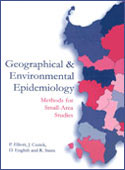Geographical and environmental epidemiology. Methods for small-area studies

Edited by P. Elliott, J. Cuzick, D. English and R. Stern
Published by Oxford University Press
1996, 382 pages
ISBN 0 19 262235 8
£85.00
The public is increasingly anxious about environmental pollution and its potential effects on health. But traditional epidemiological techniques are ill-suited to detect purely local effects, such as near certain industrial or nuclear power plants, of the kind that alarm the public the most. An important new approach to this problem is the use of small-area studies, in which health and environmental exposure data are analysed with much finer geographical resolution than ever before. This book is the first to summarize the new developments in data availability, methodology, and the execution of small-area health studies. It introduces geographical and small-area studies, summarizes the data requirements for such studies, reviews the statistical methodology and identifies areas for future work in geographical correlation studies and other concerns, gives a historical perspective of environmental epidemiology and guidelines for investigating and interpreting disease clusters, and provides some examples of small-area and geographical correlation studies. This book should be of interest to practising epidemiologists, geographers, environmentalists, statisticians, toxicologists and public health physicians concerned with the impact of environmental exposure on the health of the population. It should also be read by students of various disciplines associated with environmental epidemiology and environmental science, as well as by health-policy makers, health economists, politicians in the fields of environment and health, and informed lay people.



